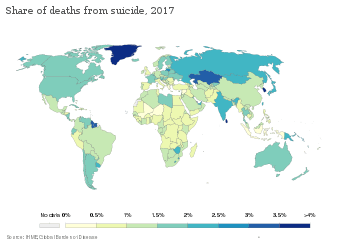Suicide
Suicide is the act of intentionally causing one's own death.[9] Mental disorders—including depression, bipolar disorder, autism, schizophrenia, personality disorders, anxiety disorders, physical disorders such as chronic fatigue syndrome, and substance abuse—including alcoholism and the use of and withdrawal from benzodiazepines—are risk factors.[2][3][10][5] Some suicides are impulsive acts due to stress (such as from financial or academic difficulties), relationship problems (such as breakups or deaths of close ones), or harrassment/bullying.[2][11][12] Those who have previously attempted suicide are at a higher risk for future attempts.[2] Effective suicide prevention efforts include limiting access to methods of suicide—such as firearms, drugs, and poisons; treating mental disorders and substance misuse; careful media reporting about suicide; and improving economic conditions.[2][13] Even though crisis hotlines are common, they have not been well studied.[14][15]
| Suicide | |
|---|---|
.jpg) | |
| The Suicide by Édouard Manet | |
| Specialty | Psychiatry, Clinical psychology, Clinical social work |
| Usual onset | >70 and 15–30 years old[1] |
| Risk factors | Depression, bipolar disorder, autism, schizophrenia, personality disorders, anxiety disorders, alcoholism, substance abuse[2][3][4][5] |
| Prevention | Limiting access to methods of suicide, treating mental disorders and substance misuse, careful media reporting about suicide, improving social and economic conditions[2] |
| Frequency | 12 per 100,000 per year[6] |
| Deaths | 793,000 / 1.5% of deaths (2016)[7][8] |
The most commonly used method of suicide varies between countries, and is partly related to the availability of effective means.[16] Common methods of suicide include hanging, pesticide poisoning, and firearms.[2][17] Suicides resulted in 828,000 global deaths in 2015, an increase from 712,000 deaths in 1990.[18][19] This makes suicide the 10th leading cause of death worldwide.[3][6]
Approximately 1.5% of people die by suicide.[8] In a given year this is roughly 12 per 100,000 people.[6] Rates of completed suicides are generally higher among men than among women, ranging from 1.5 times as much in the developing world to 3.5 times in the developed world.[1] Suicide is generally most common among those over the age of 70; however, in certain countries, those aged between 15 and 30 are at the highest risk.[1] Europe had the highest rates of suicide by region in 2015.[20] There are an estimated 10 to 20 million non-fatal attempted suicides every year.[21] Non-fatal suicide attempts may lead to injury and long-term disabilities.[22] In the Western world, attempts are more common among young people and among females.[22]
Views on suicide have been influenced by broad existential themes such as religion, honor, and the meaning of life.[23][24] The Abrahamic religions traditionally consider suicide as an offense towards God, due to the belief in the sanctity of life.[25] During the samurai era in Japan, a form of suicide known as seppuku (harakiri) was respected as a means of making up for failure or as a form of protest.[26] Sati, a practice outlawed by the British Raj, expected the Indian widow to kill herself on her husband's funeral fire, either willingly or under pressure from her family and society.[27] Suicide and attempted suicide, while previously illegal, are no longer so in most Western countries.[28] It remains a criminal offense in some countries.[29] In the 20th and 21st centuries, suicide has been used on rare occasions as a form of protest, and kamikaze and suicide bombings have been used as a military or terrorist tactic.[30] Suicide is often seen as a major catastrophe for families, relatives and other nearby supporters, and is viewed negatively almost everywhere around the world.[31][32][33]
Definitions
Suicide, from Latin suicidium, is "the act of taking one's own life".[9][34] Attempted suicide or non-fatal suicidal behavior is self-injury with at least some desire to end one's life that does not result in death.[35][36] Assisted suicide is when one individual helps another bring about their own death indirectly via providing either advice or the means to the end.[37] This is in contrast to euthanasia, where another person takes a more active role in bringing about a person's death.[37] Suicidal ideation is thoughts of ending one's life but not taking any active efforts to do so.[35] It may or may not involve exact planning or intent.[36] In a murder-suicide (or homicide-suicide), the individual aims at taking the life of others at the same time. A special case of this is extended suicide, where the murder is motivated by seeing the murdered persons as an extension of their self.[38] Suicide in which the reason is that the person feels that they are not part of society is known as egoistic suicide.[39]
The normal verb in scholarly research and journalism for the act of suicide is commit.[40][41] Some advocacy groups recommend using the terms completed suicide, took his/her own life, died by suicide, or killed him/herself instead of committed suicide.[42][43][44][45][46] The Associated Press Stylebook recommends avoiding "committed suicide" except in direct quotes from authorities.[47] Opponents of commit argue that it implies that suicide is criminal, sinful, or morally wrong.[48]
Risk factors
_(cropped).png)
Factors that affect the risk of suicide include mental disorders, drug misuse, psychological states, cultural, family and social situations, genetics, experiences of trauma or loss, and nihilism.[50][51][15] Mental disorders and substance misuse frequently co-exist.[52] Other risk factors include having previously attempted suicide,[22] the ready availability of a means to take one's life, a family history of suicide, or the presence of traumatic brain injury.[53] For example, suicide rates have been found to be greater in households with firearms than those without them.[54]
Socio-economic problems such as unemployment, poverty, homelessness, and discrimination may trigger suicidal thoughts.[55][56] Suicide might be rarer in societies with high social cohesion and moral objections against suicide.[36] About 15–40% of people leave a suicide note.[57] War veterans have a higher risk of suicide due in part to higher rates of mental illness, such as post traumatic stress disorder, and physical health problems related to war.[58] Genetics appears to account for between 38% and 55% of suicidal behaviors.[59] Suicides may also occur as a local cluster of cases.[60]
Most research does not distinguish between risk factors that lead to thinking about suicide and risk factors that lead to suicide attempts.[61][62] Risks for suicide attempt rather than just thoughts of suicide include a high pain tolerance and a reduced fear of death.[63]
Mental illness
.jpg)
Mental illness is present at the time of suicide 27% to more than 90% of the time.[64][22][65][66] Of those who have been hospitalized for suicidal behavior, the lifetime risk of completed suicide is 8.6%.[22][67] Comparatively, non-suicidal people hospitalized for affective disorders have a 4% lifetime risk of suicide.[67] Half of all people who die by suicide may have major depressive disorder; having this or one of the other mood disorders such as bipolar disorder increases the risk of suicide 20-fold.[68] Other conditions implicated include schizophrenia (14%), personality disorders (8%),[69][70] obsessive compulsive disorder,[71] and posttraumatic stress disorder.[22] Those with autism spectrum disorders also attempt and consider suicide more frequently.[72]
Others estimate that about half of people who complete suicide could be diagnosed with a personality disorder, with borderline personality disorder being the most common.[73] About 5% of people with schizophrenia die of suicide.[74] Eating disorders are another high risk condition.[75]
Among approximately 80% of completed suicides, the individual has seen a physician within the year before their death,[76] including 45% within the prior month.[77] Approximately 25–40% of those who completed suicide had contact with mental health services in the prior year.[64][76] Antidepressants of the SSRI class appear to increase the frequency of suicide among children but do not change the risk among adults.[78] An unwillingness to get help for mental health problems also increases the risk.[60]
Previous attempts and self-harm
A previous history of suicide attempts is the most accurate predictor of completed suicide.[22] Approximately 20% of suicides have had a previous attempt, and of those who have attempted suicide, 1% complete suicide within a year[22] and more than 5% die by suicide within 10 years.[75] Acts of self-harm are not usually suicide attempts and most who self-harm are not at high risk of suicide.[79] Some who self-harm, however, do still end their life by suicide, and risk for self-harm and suicide may overlap.[79]
Psychosocial factors
A number of psychological factors increase the risk of suicide including: hopelessness, loss of pleasure in life, depression, anxiousness, agitation, rigid thinking, rumination, thought suppression, and poor coping skills.[68][80][81] A poor ability to solve problems, the loss of abilities one used to have, and poor impulse control also play a role.[68][82] In older adults, the perception of being a burden to others is important.[83] Those who have never married are also at greater risk.[22] Recent life stresses, such as a loss of a family member or friend or the loss of a job, might be a contributing factor.[68][60]
Certain personality factors, especially high levels of neuroticism and introvertedness, have been associated with suicide. This might lead to people who are isolated and sensitive to distress to be more likely to attempt suicide.[80] On the other hand, optimism has been shown to have a protective effect.[80] Other psychological risk factors include having few reasons for living and feeling trapped in a stressful situation.[80] Changes to the stress response system in the brain might be altered during suicidal states.[36] Specifically, changes in the polyamine system[84] and hypothalamic–pituitary–adrenal axis.[85]
Social isolation and the lack of social support has been associated with an increased risk of suicide.[80] Poverty is also a factor,[86] with heightened relative poverty compared to those around a person increasing suicide risk.[87] Over 200,000 farmers in India have died by suicide since 1997, partly due to issues of debt.[88] In China, suicide is three times as likely in rural regions as urban ones, partly, it is believed, due to financial difficulties in this area of the country.[89]
The time of year may also affect suicide rates. There appears to be a decrease around Christmas,[90] but an increase in rates during spring and summer, which might be related to exposure to sunshine.[36] Another study found that the risk may be greater for males on their birthday.[91]
Being religious may reduce one's risk of suicide while beliefs that suicide is noble may increase it.[92][60][93] This has been attributed to the negative stance many religions take against suicide and to the greater connectedness religion may give.[92] Muslims, among religious people, appear to have a lower rate of suicide; however the data supporting this is not strong.[29] There does not appear to be a difference in rates of attempted suicide.[29] Young women in the Middle East may have higher rates.[94]
Substance misuse

Substance misuse is the second most common risk factor for suicide after major depression and bipolar disorder.[95] Both chronic substance misuse as well as acute intoxication are associated.[52][96] When combined with personal grief, such as bereavement, the risk is further increased.[96] Substance misuse is also associated with mental health disorders.[52]
Most people are under the influence of sedative-hypnotic drugs (such as alcohol or benzodiazepines) when they die by suicide,[97] with alcoholism present in between 15% and 61% of cases.[52] Use of prescribed benzodiazepines is associated with an increased rate of attempted and completed suicide. The pro-suicidal effects of benzodiazepines are suspected to be due to a psychiatric disturbance caused by side effects, such as disinhibition, or withdrawal symptoms.[10] Countries that have higher rates of alcohol use and a greater density of bars generally also have higher rates of suicide.[98] About 2.2–3.4% of those who have been treated for alcoholism at some point in their life die by suicide.[98] Alcoholics who attempt suicide are usually male, older, and have tried to take their own lives in the past.[52] Between 3 and 35% of deaths among those who use heroin are due to suicide (approximately fourteenfold greater than those who do not use).[99] In adolescents who misuse alcohol, neurological and psychological dysfunctions may contribute to the increased risk of suicide.[100]
The misuse of cocaine and methamphetamine has a high correlation with suicide.[52][101] In those who use cocaine, the risk is greatest during the withdrawal phase.[102] Those who used inhalants are also at significant risk with around 20% attempting suicide at some point and more than 65% considering it.[52] Smoking cigarettes is associated with risk of suicide.[103] There is little evidence as to why this association exists; however, it has been hypothesized that those who are predisposed to smoking are also predisposed to suicide, that smoking causes health problems which subsequently make people want to end their life, and that smoking affects brain chemistry causing a propensity for suicide.[103] Cannabis, however, does not appear to independently increase the risk.[52]
Medical conditions
There is an association between suicidality and physical health problems such as[75] chronic pain,[104] traumatic brain injury,[105] cancer,[106] chronic fatigue syndrome, kidney failure (requiring hemodialysis), HIV, and systemic lupus erythematosus.[75] The diagnosis of cancer approximately doubles the subsequent frequency of suicide.[106] The prevalence of increased suicidality persisted after adjusting for depressive illness and alcohol abuse. Among people with more than one medical condition the frequency was particularly high. In Japan, health problems are listed as the primary justification for suicide.[107]
Sleep disturbances, such as insomnia[108] and sleep apnea, are risk factors for depression and suicide. In some instances, the sleep disturbances may be a risk factor independent of depression.[109] A number of other medical conditions may present with symptoms similar to mood disorders, including hypothyroidism, Alzheimer's, brain tumors, systemic lupus erythematosus, and adverse effects from a number of medications (such as beta blockers and steroids).[22]
Media

The media, including the Internet, plays an important role.[50][80] Certain depictions of suicide may increase its occurrence, with high-volume, prominent, repetitive coverage glorifying or romanticizing suicide having the most impact.[110] When detailed descriptions of how to kill oneself by a specific means are portrayed, this method of suicide can be imitated in vulnerable people.[16] This phenomenon has been observed in several cases after press coverage.[111][112] In a bid to reduce the adverse effect of media portrayals concerning suicide report, one of the effective methods is to educate journalists on how to report suicide news in a manner that might reduce that possibility of imitation and encourage those at risk to seek for help.When journalists follow certain reporting guidelines the risk of suicides can be decreased.[110] Getting buy-in from the media industry, however, can be difficult, especially in the long term.[110]
This trigger of suicide contagion or copycat suicide is known as the "Werther effect", named after the protagonist in Goethe's The Sorrows of Young Werther who killed himself and then was emulated by many admirers of the book.[113] This risk is greater in adolescents who may romanticize death.[114] It appears that while news media has a significant effect; that of the entertainment media is equivocal.[115][116] It is unclear if searching for information about suicide on the Internet relates to the risk of suicide.[117] The opposite of the Werther effect is the proposed "Papageno effect", in which coverage of effective coping mechanisms may have a protective effect. The term is based upon a character in Mozart's opera The Magic Flute—fearing the loss of a loved one, he had planned to kill himself until his friends helped him out.[113] As a consequence, fictional portrayals of suicide, showing alternative consequences or negative consequences, might have a preventive effect,[118] for instance fiction might normalize mental health problems and encouraging help-seeking.[119]
Other factors
Trauma is a risk factor for suicidality in both children[120] and adults.[80] Some may take their own lives to escape bullying or prejudice.[121] A history of childhood sexual abuse[122] and time spent in foster care are also risk factors.[123] Sexual abuse is believed to contribute to approximately 20% of the overall risk.[59] Significant adversity early in life has a negative effect on problem-solving skills and memory, both of which are implicated in suicidality.[36]
Problem gambling is associated with increased suicidal ideation and attempts compared to the general population.[124] Between 12 and 24% pathological gamblers attempt suicide.[125] The rate of suicide among their spouses is three times greater than that of the general population.[125] Other factors that increase the risk in problem gamblers include concomitant mental illness, alcohol, and drug misuse.[126]
Genetics might influence rates of completed suicides. A family history of suicide, especially in the mother, affects children more than adolescents or adults.[80] Adoption studies have shown that this is the case for biological relatives, but not adopted relatives. This makes familial risk factors unlikely to be due to imitation.[36] Once mental disorders are accounted for, the estimated heritability rate is 36% for suicidal ideation and 17% for suicide attempts.[36] An evolutionary explanation for suicide is that it may improve inclusive fitness. This may occur if the person dying by suicide cannot have more children and takes resources away from relatives by staying alive. An objection is that deaths by healthy adolescents likely does not increase inclusive fitness. Adaptation to a very different ancestral environment may be maladaptive in the current one.[82][127]
Infection by the parasite Toxoplasma gondii, more commonly known as toxoplasmosis, has been linked with suicide risk. One explanation states that this is caused by altered neurotransmitter activity due to the immunological response.[36]
There appears to be a link between air pollution and depression and suicide.[128]
Rational

Rational suicide is the reasoned taking of one's own life.[129] However, some consider suicide as never being rational.[129]
Euthanasia and assisted suicide are accepted practices in a number of countries among those who have a poor quality of life without the possibility of getting better.[130][131] They are supported by the legal arguments for a right to die.[131]
The act of taking one's life for the benefit of others is known as altruistic suicide.[132] An example of this is an elder ending his or her life to leave greater amounts of food for the younger people in the community.[132] Suicide in some Inuit cultures has been seen as an act of respect, courage, or wisdom.[133]
A suicide attack is a political or religious action where an attacker carries out violence against others which they understand will result in their own death.[134] Some suicide bombers are motivated by a desire to obtain martyrdoms or are religiously motivated.[58] Kamikaze missions were carried out as a duty to a higher cause or moral obligation.[133] Murder–suicide is an act of homicide followed within a week by suicide of the person who carried out the act.[135]
Mass suicides are often performed under social pressure where members give up autonomy to a leader.[136] Mass suicides can take place with as few as two people, often referred to as a suicide pact.[137] In extenuating situations where continuing to live would be intolerable, some people use suicide as a means of escape.[138][139] Some inmates in Nazi concentration camps are known to have killed themselves by deliberately touching the electrified fences.[140]
Methods
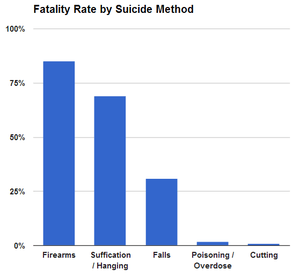
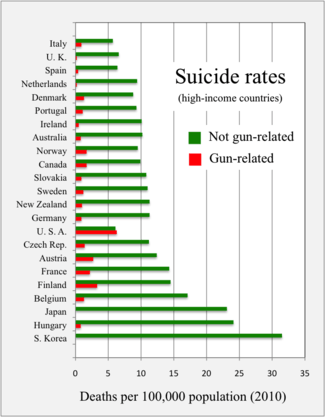
The leading method of suicide varies among countries. The leading methods in different regions include hanging, pesticide poisoning, and firearms.[17] These differences are believed to be in part due to availability of the different methods.[16] A review of 56 countries found that hanging was the most common method in most of the countries,[17] accounting for 53% of male suicides and 39% of female suicides.[142]
Worldwide, 30% of suicides are estimated to occur from pesticide poisoning, most of which occur in the developing world.[2] The use of this method varies markedly from 4% in Europe to more than 50% in the Pacific region.[143] It is also common in Latin America due to the ease of access within the farming populations.[16] In many countries, drug overdoses account for approximately 60% of suicides among women and 30% among men.[144] Many are unplanned and occur during an acute period of ambivalence.[16] The death rate varies by method: firearms 80–90%, drowning 65–80%, hanging 60–85%, car exhaust 40–60%, jumping 35–60%, charcoal burning 40–50%, pesticides 60–75%, and medication overdose 1.5–4.0%.[16] The most common attempted methods of suicide differ from the most common methods of completion; up to 85% of attempts are via drug overdose in the developed world.[75]
In China, the consumption of pesticides is the most common method.[145] In Japan, self-disembowelment known as seppuku (harakiri) still occurs;[145] however, hanging, and jumping are the most common.[146] Jumping to one's death is common in both Hong Kong and Singapore at 50% and 80% respectively.[16] In Switzerland, firearms are the most frequent suicide method in young males, however this method has decreased relatively since guns have become less common.[147][148] In the United States, 50% of suicides involve the use of firearms, with this method being somewhat more common in men (56%) than women (31%).[149] The next most common cause was hanging in males (28%) and self-poisoning in females (31%).[149] Together, hanging and poisoning constituted about 42% of U.S. suicides (as of 2017).[149]
Pathophysiology
There is no known unifying underlying pathophysiology for suicide.[22] It is however believed to result from an interplay of behavioral, socio economic and psychological factors.[16]
Low levels of brain-derived neurotrophic factor (BDNF) are both directly associated with suicide[150] and indirectly associated through its role in major depression, posttraumatic stress disorder, schizophrenia and obsessive–compulsive disorder.[151] Post-mortem studies have found reduced levels of BDNF in the hippocampus and prefrontal cortex, in those with and without psychiatric conditions.[152] Serotonin, a brain neurotransmitter, is believed to be low in those who die by suicide.[153] This is partly based on evidence of increased levels of 5-HT2A receptors found after death.[154] Other evidence includes reduced levels of a breakdown product of serotonin, 5-hydroxyindoleacetic acid, in the cerebral spinal fluid.[155] Direct evidence is however hard to gather.[154] Epigenetics, the study of changes in genetic expression in response to environmental factors which do not alter the underlying DNA, is also believed to play a role in determining suicide risk.[156]
Prevention
.jpg)
Suicide prevention is a term used for the collective efforts to reduce the incidence of suicide through preventive measures. Protective factors for suicide include support, and access to therapy.[51] About 60% of people with suicidal thoughts do not seek help.[157] Reasons for not doing so include low perceived need, and wanting to deal with the problem alone.[157] Despite these high rates, there are few established treatments available for suicidal behavior.[80]
Reducing access to certain methods, such as firearms or toxins such as opioids and pesticides, can reduce risk of suicide by that method.[16][158][15][36] This may be in part because suicide is often an impulsive decision, with up to 70% of near-fatal suicide attempts made after less than one hour of deliberation—thus, reducing access to easily-accessible methods of suicide may make impulsive attempts less likely to succeed.[159] Other measures include reducing access to charcoal (for burning) and adding barriers on bridges and subway platforms.[16][160][15] Treatment of drug and alcohol addiction, depression, and those who have attempted suicide in the past, may also be effective.[158][15] Some have proposed reducing access to alcohol as a preventive strategy (such as reducing the number of bars).[52]
In young adults who have recently thought about suicide, cognitive behavioral therapy appears to improve outcomes.[161][80] School-based programs that increase mental health literacy and train staff have shown mixed results on suicide rates.[15] Economic development through its ability to reduce poverty may be able to decrease suicide rates.[86] Efforts to increase social connection, especially in elderly males, may be effective.[162] In people who have attempted suicide, following up on them might prevent repeat attempts.[163] Although crisis hotlines are common, there is little evidence to support or refute their effectiveness.[14][15] Preventing childhood trauma provides an opportunity for suicide prevention.[120] The World Suicide Prevention Day is observed annually on September 10 with the support of the International Association for Suicide Prevention and the World Health Organization.[164]
Screening
There is little data on the effects of screening the general population on the ultimate rate of suicide.[165][166] Screening those who come to the emergency departments with injuries from self-harm have been shown to help identify suicide ideation and suicide intention. Psychometric tests such as the Beck Depression Inventory or the Geriatric Depression Scale for older people are being used.[167] As there is a high rate of people who test positive via these tools that are not at risk of suicide, there are concerns that screening may significantly increase mental health care resource utilization.[168] Assessing those at high risk however is recommended.[22] Asking about suicidality does not appear to increase the risk.[22]
Mental illness
In those with mental health problems, a number of treatments may reduce the risk of suicide. Those who are actively suicidal may be admitted to psychiatric care either voluntarily or involuntarily.[22] Possessions that may be used to harm oneself are typically removed.[75] Some clinicians get patients to sign suicide prevention contracts where they agree to not harm themselves if released.[22] Evidence however does not support a significant effect from this practice.[22] If a person is at low risk, outpatient mental health treatment may be arranged.[75] Short-term hospitalization has not been found to be more effective than community care for improving outcomes in those with borderline personality disorder who are chronically suicidal.[169][170]
There is tentative evidence that psychotherapy, specifically dialectical behaviour therapy, reduces suicidality in adolescents[171] as well as in those with borderline personality disorder.[172] It may also be useful in decreasing suicide attempts in adults at high risk.[173] Evidence however has not found a decrease in completed suicides.[171]
There is controversy around the benefit-versus-harm of antidepressants.[50] In young persons, some antidepressants, such as SSRIs, appear to increase the risk of suicidality from 25 per 1000 to 40 per 1000.[174] In older persons, however, they may decrease the risk.[22] Lithium appears effective at lowering the risk in those with bipolar disorder and major depression to nearly the same levels as that of the general population.[175][176] Clozapine may decrease the thoughts of suicide in some people with schizophrenia.[177] Ketamine, which is a dissociative anaesthetic, seems to lower the rate of suicidal ideation.[178] In the United States, health professionals are legally required to take reasonable steps to try to prevent suicide.[179][180]
Epidemiology
Approximately 0.5% to 1.4% of people die by suicide, a mortality rate of 11.6 per 100,000 persons per year.[6][22] Suicide resulted in 842,000 deaths in 2013 up from 712,000 deaths in 1990.[19] Rates of suicide have increased by 60% from the 1960s to 2012, with these increases seen primarily in the developing world.[3] Globally, as of 2008/2009, suicide is the tenth leading cause of death.[3] For every suicide that results in death there are between 10 and 40 attempted suicides.[22]
Suicide rates differ significantly between countries and over time.[6] As a percentage of deaths in 2008 it was: Africa 0.5%, South-East Asia 1.9%, Americas 1.2% and Europe 1.4%.[6] Rates per 100,000 were: Australia 8.6, Canada 11.1, China 12.7, India 23.2, United Kingdom 7.6, United States 11.4 and South Korea 28.9.[181][182] It was ranked as the 10th leading cause of death in the United States in 2016 with about 45,000 cases that year.[183] Rates have increased in the United States in the last few years,[183] with the highest value being in 2017 (the most recent data).[184] In the United States, about 650,000 people are seen in emergency departments yearly due to attempting suicide.[22] The United States rate among men in their 50s rose by nearly half in the decade 1999–2010.[185] Lithuania, Japan, and Hungary have the highest rates of suicide.[6] Around 75% of suicides occur in the developing world.[2] The countries with the greatest absolute numbers of suicides are China and India, partly due to their large population size, accounting for over half the total.[6] In China, suicide is the 5th leading cause of death.[186]
Sex and gender
.svg.png)
.svg.png)
|
0 - 5
5 - 10
|
10 - 15
15 - 25
|
25 - 35
Above 35
|
No data
|
Globally as of 2012, death by suicide occurs about 1.8 times more often in males than females.[6][189] In the Western world, males die three to four times more often by means of suicide than do females.[6] This difference is even more pronounced in those over the age of 65, with tenfold more males than females dying by suicide.[190] Suicide attempts and self-harm are between two and four times more frequent among females.[22][191][192] Researchers have attributed the difference between attempted and completed suicides among the sexes to males using more lethal means to end their lives.[190][193][194] However, separating intentional suicide attempts from non-suicidal self-harm is not currently done in places like the United States when gathering statistics at the national level.[195]
China has one of the highest female suicide rates in the world and is the only country where it is higher than that of men (ratio of 0.9).[6][186] In the Eastern Mediterranean, suicide rates are nearly equivalent between males and females.[6] The highest rate of female suicide is found in South Korea at 22 per 100,000, with high rates in South-East Asia and the Western Pacific generally.[6]
A number of reviews have found an increased risk of suicide among transgender, lesbian, gay, and bisexual people.[196][197] Among transgender persons, rates of attempted suicide are about 40% compared to a general population rate of 5%.[198][199] This is believed to in part be due to social stigmatisation.[200]
Age
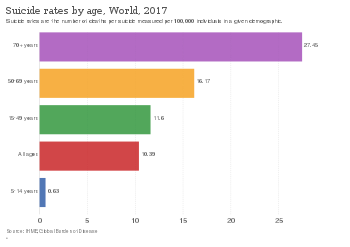
In many countries, the rate of suicide is highest in the middle-aged[202] or elderly.[16] The absolute number of suicides however is greatest in those between 15 and 29 years old, due to the number of people in this age group.[6] Worldwide, the average age of suicide is between age 30 and 49 for both men and women.[203] This means that half of people who died by suicide were approximately age 40 or younger, and half were older.[203] Suicidality is rare in children, but increases during the transition to adolescence.[204]
In the United States, the suicide death rate is greatest in Caucasian men older than 80 years, even though younger people more frequently attempt suicide.[22] It is the second most common cause of death in adolescents[50] and in young males is second only to accidental death.[202] In young males in the developed world, it is the cause of nearly 30% of mortality.[202] In the developing world rates are similar, but it makes up a smaller proportion of overall deaths due to higher rates of death from other types of trauma.[202] In South-East Asia, in contrast to other areas of the world, deaths from suicide occur at a greater rate in young females than elderly females.[6]
History

In ancient Athens, a person who died by suicide without the approval of the state was denied the honors of a normal burial. The person would be buried alone, on the outskirts of the city, without a headstone or marker.[205] However, it was deemed to be an acceptable method to deal with military defeat.[206] In Ancient Rome, while suicide was initially permitted, it was later deemed a crime against the state due to its economic costs.[207] Aristotle condemned all forms of suicide while Plato was ambivalent.[208] In Rome, some reasons for suicide included volunteering death in a gladiator combat, guilt over murdering someone, to save the life of another, as a result of mourning, from shame from being raped, and as an escape from intolerable situations like physical suffering, military defeat, or criminal pursuit.[208]

Suicide came to be regarded as a sin in Christian Europe and was condemned at the Council of Arles (452) as the work of the Devil. In the Middle Ages, the Church had drawn-out discussions as to when the desire for martyrdom was suicidal, as in the case of martyrs of Córdoba. Despite these disputes and occasional official rulings, Catholic doctrine was not entirely settled on the subject of suicide until the later 17th century. A criminal ordinance issued by Louis XIV of France in 1670 was extremely severe, even for the times: the dead person's body was drawn through the streets, face down, and then hung or thrown on a garbage heap. Additionally, all of the person's property was confiscated.[209][210]
Attitudes towards suicide slowly began to shift during the Renaissance. John Donne's work Biathanatos contained one of the first modern defences of suicide, bringing proof from the conduct of Biblical figures, such as Jesus, Samson and Saul, and presenting arguments on grounds of reason and nature to sanction suicide in certain circumstances.[211]
The secularization of society that began during the Enlightenment questioned traditional religious attitudes (such as Christian views on suicide) toward suicide and brought a more modern perspective to the issue. David Hume denied that suicide was a crime as it affected no one and was potentially to the advantage of the individual. In his 1777 Essays on Suicide and the Immortality of the Soul he rhetorically asked, "Why should I prolong a miserable existence, because of some frivolous advantage which the public may perhaps receive from me?"[211] A shift in public opinion at large can also be discerned; The Times in 1786 initiated a spirited debate on the motion "Is suicide an act of courage?".[212]
By the 19th century, the act of suicide had shifted from being viewed as caused by sin to being caused by insanity in Europe.[210] Although suicide remained illegal during this period, it increasingly became the target of satirical comments, such as the Gilbert and Sullivan comic opera The Mikado, that satirized the idea of executing someone who had already killed himself.
By 1879, English law began to distinguish between suicide and homicide, although suicide still resulted in forfeiture of estate.[213] In 1882, the deceased were permitted daylight burial in England[214] and by the middle of the 20th century, suicide had become legal in much of the Western world. The term suicide first emerged shortly before 1700 to replace expressions on self-death which were often characterized as a form of self-murder in the West.[208]
Social and culture
Legislation

No country in Europe currently considers suicide or attempted suicide to be a crime.[215] It was, however, in most Western European countries from the Middle Ages until at least the 1800s.[213] The Netherlands was the first country to legalize both physician-assisted suicide and euthanasia, which took effect in 2002, although only doctors are allowed to assist in either of them, and have to follow a protocol prescribed by Dutch law.[216] If such protocol is not followed, it is an offence punishable by law. In Germany, active euthanasia is illegal and anyone present during suicide may be prosecuted for failure to render aid in an emergency.[217] Switzerland has taken steps to legalize assisted suicide for the chronically mentally ill. The high court in Lausanne, Switzerland, in a 2006 ruling, granted an anonymous individual with longstanding psychiatric difficulties the right to end his own life.[218] England and Wales decriminalized suicide via the Suicide Act 1961 and the Republic of Ireland in 1993.[215] The word "commit" was used in reference to its being illegal, however many organisations have stopped it because of the negative connotation.[219][220]
In the United States, suicide is not illegal but may be associated with penalties for those who attempt it.[215] Physician-assisted suicide is legal in the state of Washington for people with terminal diseases.[221] In Oregon, people with terminal diseases may request medications to help end their life.[222] Canadians who have attempted suicide may be barred from entering the United States. U.S. laws allow border guards to deny access to people who have a mental illness, including those with previous suicide attempts.[223][224]
In Australia, suicide is not a crime.[225] It however is a crime to counsel, incite, or aid and abet another in attempting to die by suicide, and the law explicitly allows any person to use "such force as may reasonably be necessary" to prevent another from taking their own life.[226] The Northern Territory of Australia briefly had legal physician-assisted suicide from 1996 to 1997.[227]
In India, suicide used to be illegal and surviving family could face legal difficulties.[228] The Indian government repealed this law in 2014.[229] It remains a criminal offense in most Muslim-majority nations.[29]
Religious views

In most forms of Christianity, suicide is considered a sin, based mainly on the writings of influential Christian thinkers of the Middle Ages, such as St. Augustine and St. Thomas Aquinas, but suicide was not considered a sin under the Byzantine Christian code of Justinian, for instance.[230][231] In Catholic doctrine, the argument is based on the commandment "Thou shalt not kill" (made applicable under the New Covenant by Jesus in the Gospel of Matthew[232]), as well as the idea that life is a gift given by God which should not be spurned, and that suicide is against the "natural order" and thus interferes with God's master plan for the world.[233] However, it is believed that mental illness or grave fear of suffering diminishes the responsibility of the one completing suicide.[234]
Judaism focuses on the importance of valuing this life, and as such, suicide is tantamount to denying God's goodness in the world. Despite this, under extreme circumstances when there has seemed no choice but to either be killed or forced to betray their religion, Jews have committed individual suicide or mass suicide (see Masada, First French persecution of the Jews, and York Castle for examples) and as a grim reminder there is even a prayer in the Jewish liturgy for "when the knife is at the throat", for those dying "to sanctify God's Name" (see Martyrdom). These acts have received mixed responses by Jewish authorities, regarded by some as examples of heroic martyrdom, while others state that it was wrong for them to take their own lives in anticipation of martyrdom.[235]
Islamic religious views are against suicide.[29] The Quran forbids it by stating "do not kill or destroy yourself".[236] The hadiths also state individual suicide to be unlawful and a sin.[29] Stigma is often associated with suicide in Islamic countries.[236]
In Hinduism, suicide is generally frowned upon and is considered equally sinful as murdering another in contemporary Hindu society. Hindu Scriptures state that one who dies by suicide will become part of the spirit world, wandering earth until the time one would have otherwise died, had one not taken one's own life.[237] However, Hinduism accepts a man's right to end one's life through the non-violent practice of fasting to death, termed Prayopavesa;[238] but Prayopavesa is strictly restricted to people who have no desire or ambition left, and no responsibilities remaining in this life.[238] Jainism has a similar practice named Santhara. Sati, or self-immolation by widows, is a rare and illegal practice in Hindu society.[239]
Within the Ainu religion, someone who commits suicide is believed to become a ghost (tukap) who would haunt the living,[240] to come to fulfillment from which he was excluded during life.[241] Also, someone who insults another so he commits suicide is regarded as co-responsible for his death.[242] According to Norbert Richard Adami, this ethics exists due to the case that solidarity within the community is much more important to Ainu culture than it is to the Western world.[242]
Philosophy
A number of questions are raised within the philosophy of suicide, including what constitutes suicide, whether or not suicide can be a rational choice, and the moral permissibility of suicide.[243] Arguments as to acceptability of suicide in moral or social terms range from the position that the act is inherently immoral and unacceptable under any circumstances, to a regard for suicide as a sacrosanct right of anyone who believes they have rationally and conscientiously come to the decision to end their own lives, even if they are young and healthy.
Opponents to suicide include Christian philosophers such as Augustine of Hippo, Thomas Aquinas,[243] Immanuel Kant[244] and, arguably, John Stuart Mill – Mill's focus on the importance of liberty and autonomy meant that he rejected choices which would prevent a person from making future autonomous decisions.[245] Others view suicide as a legitimate matter of personal choice. Supporters of this position maintain that no one should be forced to suffer against their will, particularly from conditions such as incurable disease, mental illness, and old age, with no possibility of improvement. They reject the belief that suicide is always irrational, arguing instead that it can be a valid last resort for those enduring major pain or trauma.[246] A stronger stance would argue that people should be allowed to autonomously choose to die regardless of whether they are suffering. Notable supporters of this school of thought include Scottish empiricist David Hume[243] and American bioethicist Jacob Appel.[218][247]
Advocacy

Advocacy of suicide has occurred in many cultures and subcultures. The Japanese military during World War II encouraged and glorified kamikaze attacks, which were suicide attacks by military aviators from the Empire of Japan against Allied naval vessels in the closing stages of the Pacific Theater of World War II. Japanese society as a whole has been described as "suicide-tolerant"[249] (see Suicide in Japan).
Internet searches for information on suicide return webpages that 10–30% of the time encourage or facilitate suicide attempts. There is some concern that such sites may push those predisposed over the edge. Some people form suicide pacts online, either with pre-existing friends or people they have recently encountered in chat rooms or message boards. The Internet, however, may also help prevent suicide by providing a social group for those who are isolated.[250]
Locations
Some landmarks have become known for high levels of suicide attempts.[251] These include China's Nanjing Yangtze River Bridge,[252] San Francisco's Golden Gate Bridge, Japan's Aokigahara Forest,[253] England's Beachy Head,[251] and Toronto's Bloor Street Viaduct.[254] As of 2010, the Golden Gate Bridge has had more than 1,300 die by suicide by jumping since its construction in 1937.[255] Many locations where suicide is common have constructed barriers to prevent it;[256] this includes the Luminous Veil in Toronto,[254] the Eiffel Tower in Paris, the West Gate Bridge in Melbourne, and Empire State Building in New York City.[256] They generally appear to be effective.[257]
Notable cases

An example of mass suicide is the 1978 Jonestown mass murder/suicide in which 909 members of the Peoples Temple, an American new religious movement led by Jim Jones, ended their lives by drinking grape Flavor Aid laced with cyanide and various prescription drugs.[258][259][260]
Thousands of Japanese civilians took their own lives in the last days of the Battle of Saipan in 1944, some jumping from "Suicide Cliff" and "Banzai Cliff".[261] The 1981 Irish hunger strikes, led by Bobby Sands, resulted in 10 deaths. The cause of death was recorded by the coroner as "starvation, self-imposed" rather than suicide; this was modified to simply "starvation" on the death certificates after protest from the dead strikers' families.[262] During World War II, Erwin Rommel was found to have foreknowledge of the July 20 plot on Hitler's life; he was threatened with public trial, execution, and reprisals on his family unless he took his own life.[263]
Other species
As suicide requires a willful attempt to die, some feel it therefore cannot be said to occur in non-human animals.[206] Suicidal behavior has been observed in Salmonella seeking to overcome competing bacteria by triggering an immune system response against them.[264] Suicidal defenses by workers are also noted in the Brazilian ant Forelius pusillus, where a small group of ants leaves the security of the nest after sealing the entrance from the outside each evening.[265]
Pea aphids, when threatened by a ladybug, can explode themselves, scattering and protecting their brethren and sometimes even killing the ladybug, this form of suicidal altruism is known as autothysis.[266] Some species of termites (for example Globitermes sulphureus[267]) have soldiers that explode, covering their enemies with sticky goo.[268][269]
There have been anecdotal reports of dogs, horses, and dolphins killing themselves,[270] but little scientific study of animal suicide.[271] Animal suicide is usually put down to romantic human interpretation and is not generally thought to be intentional. Some of the reasons animals are thought to unintentionally kill themselves include: psychological stress, infection by certain parasites or fungi, or disruption of a long-held social tie, such as the ending of a long association with an owner and thus not accepting food from another individual.[272]
References
- Preventing suicide: a global imperative. WHO. 2014. pp. 7, 20, 40. ISBN 978-92-4-156477-9.
- "Suicide Fact sheet N°398". WHO. April 2016. Archived from the original on 4 March 2016. Retrieved 3 March 2016.
- Hawton K, van Heeringen K (April 2009). "Suicide". Lancet. 373 (9672): 1372–81. doi:10.1016/S0140-6736(09)60372-X. PMID 19376453. S2CID 208790312.
- De La Vega D, Giner L, Courtet P (March 2018). "Suicidality in Subjects With Anxiety or Obsessive-Compulsive and Related Disorders: Recent Advances". Current Psychiatry Reports. 20 (4): 26. doi:10.1007/s11920-018-0885-z. PMID 29594718. S2CID 4549236.
- Richa S, Fahed M, Khoury E, Mishara B (2014). "Suicide in autism spectrum disorders". Archives of Suicide Research. 18 (4): 327–39. doi:10.1080/13811118.2013.824834. PMID 24713024. S2CID 25741716.
- Värnik P (March 2012). "Suicide in the world". International Journal of Environmental Research and Public Health. 9 (3): 760–71. doi:10.3390/ijerph9030760. PMC 3367275. PMID 22690161.
- "Suicide across the world (2016)". World Health Organization. 2019-09-27. Retrieved 2019-10-16.
- Fazel S, Runeson B (January 2020). "Suicide". New England Journal of Medicine. 382 (3): 266–74. doi:10.1056/NEJMra1902944. PMID 31940700. S2CID 210332277.
- Stedman's Medical Dictionary (28th ed.). Philadelphia: Lippincott Williams & Wilkins. 2006. ISBN 978-0-7817-3390-8.
- Dodds TJ (March 2017). "Prescribed Benzodiazepines and Suicide Risk: A Review of the Literature". The Primary Care Companion for CNS Disorders. 19 (2). doi:10.4088/PCC.16r02037. PMID 28257172.
- Bottino SM, Bottino CM, Regina CG, Correia AV, Ribeiro WS (March 2015). "Cyberbullying and adolescent mental health: systematic review". Cadernos de Saude Publica. 31 (3): 463–75. doi:10.1590/0102-311x00036114. PMID 25859714.
- "Suicide rates rising across the U.S. | CDC Online Newsroom | CDC". www.cdc.gov. 11 April 2019. Retrieved 19 September 2019.
Relationship problems or loss, substance misuse; physical health problems; and job, money, legal or housing stress often contributed to risk for suicide.
- Preventing Suicide A Resource for Media Professionals (PDF). 2008. ISBN 978-92-4-159707-4.
- Sakinofsky I (June 2007). "The current evidence base for the clinical care of suicidal patients: strengths and weaknesses". Canadian Journal of Psychiatry. 52 (6 Suppl 1): 7S–20S. PMID 17824349.
Other suicide prevention strategies that have been considered are crisis centres and hotlines, method control, and media education... There is minimal research on these strategies. Even though crisis centres and hotlines are used by suicidal youth, information about their impact on suicidal behaviour is lacking.
- Zalsman G, Hawton K, Wasserman D, van Heeringen K, Arensman E, Sarchiapone M, et al. (July 2016). "Suicide prevention strategies revisited: 10-year systematic review". The Lancet. Psychiatry. 3 (7): 646–59. doi:10.1016/S2215-0366(16)30030-X. PMID 27289303.
Other approaches that need further investigation include gatekeeper training, education of physicians, and internet and helpline support.
- Yip PS, Caine E, Yousuf S, Chang SS, Wu KC, Chen YY (June 2012). "Means restriction for suicide prevention". Lancet. 379 (9834): 2393–9. doi:10.1016/S0140-6736(12)60521-2. PMC 6191653. PMID 22726520.
- Ajdacic-Gross V, Weiss MG, Ring M, Hepp U, Bopp M, Gutzwiller F, Rössler W (September 2008). "Methods of suicide: international suicide patterns derived from the WHO mortality database". Bulletin of the World Health Organization. 86 (9): 726–32. doi:10.2471/BLT.07.043489. PMC 2649482. PMID 18797649.
- Wang H, Naghavi M, Allen C, Barber RM, Bhutta ZA, Carter A, et al. (GBD 2015 Mortality and Causes of Death Collaborators) (October 2016). "Global, regional, and national life expectancy, all-cause mortality, and cause-specific mortality for 249 causes of death, 1980–2015: a systematic analysis for the Global Burden of Disease Study 2015". Lancet. 388 (10053): 1459–1544. doi:10.1016/S0140-6736(16)31012-1. PMC 5388903. PMID 27733281.
- Naghavi M, Wang H, Lozano R, Davis A, Liang X, Zhou M, et al. (GBD 2013 Mortality and Causes of Death Collaborators) (January 2015). "Global, regional, and national age-sex specific all-cause and cause-specific mortality for 240 causes of death, 1990–2013: a systematic analysis for the Global Burden of Disease Study 2013". Lancet. 385 (9963): 117–71. doi:10.1016/S0140-6736(14)61682-2. PMC 4340604. PMID 25530442.
- "Suicide rates per (100 000 population)". World Health Organization.
- Bertolote JM, Fleischmann A (October 2002). "Suicide and psychiatric diagnosis: a worldwide perspective". World Psychiatry. 1 (3): 181–5. PMC 1489848. PMID 16946849.
- Chang B, Gitlin D, Patel R (September 2011). "The depressed patient and suicidal patient in the emergency department: evidence-based management and treatment strategies". Emergency Medicine Practice. 13 (9): 1–23, quiz 23–4. PMID 22164363.
- Tomer A (2013). Existential and Spiritual Issues in Death Attitudes. Psychology Press. p. 282. ISBN 978-1-136-67690-1.
- Ritzer G, Stepnisky J, eds. (2011). The Wiley-Blackwell companion to major social theorists. Malden, MA: Wiley-Blackwell. p. 65. ISBN 978-1-4443-9660-7.
- God, Religion, Science, Nature, Culture, and Morality. Archway Publishing. 2014. p. 254. ISBN 978-1-4808-1124-9.
- Colt, George Howe (1992). The enigma of suicide (1st Touchstone ed.). New York: Simon & Schuster. p. 139. ISBN 978-0-671-76071-7.
- "Indian woman commits sati suicide". Bbc.co.uk. 2002-08-07. Archived from the original on 2011-02-02. Retrieved 2010-08-26.
- White T (2010). Working with suicidal individuals : a guide to providing understanding, assessment and support. London: Jessica Kingsley Publishers. p. 12. ISBN 978-1-84905-115-6.
- Lester D (2006). "Suicide and islam". Archives of Suicide Research. 10 (1): 77–97. doi:10.1080/13811110500318489. PMID 16287698. S2CID 35754641.
- Aggarwal N (2009). "Rethinking suicide bombing". Crisis. 30 (2): 94–7. doi:10.1027/0227-5910.30.2.94. PMID 19525169. S2CID 35560934.
- Noyes, Russell Jr (1968-05-01). "The Taboo of Suicide". Psychiatry. 31 (2): 173–183. doi:10.1080/00332747.1968.11023545. ISSN 0033-2747. PMID 27780435.
- Vaughan, Megan. "The 'discovery' of suicide in Africa". BBC. Retrieved 2020-06-16.
- "Suicide". World Health Organization. Retrieved 2020-06-16.
- Issues in Law & Medicine, Volume 3. National Legal Center for the Medically Dependent & Disabled, Incorporated, and the Horatio R. Storer Foundation, Incorporated. 1987. p. 39.
- Krug E (2002). World Report on Violence and Health. 1. Genève: World Health Organization. p. 185. ISBN 978-92-4-154561-7.
- Turecki G, Brent DA (March 2016). "Suicide and suicidal behaviour". Lancet. 387 (10024): 1227–39. doi:10.1016/S0140-6736(15)00234-2. PMC 5319859. PMID 26385066.
- Gullota TP, Bloom M (2002). Encyclopedia of Primary Prevention and Health Promotion. New York: Kluwer Academic/Plenum. p. 1112. ISBN 978-0-306-47296-1.
- Lester D (2009). "Extended suicide". In Wasserman D, Wasserman C (eds.). Oxford textbook of suicidology. Oxford: Oxford University Press. pp. 134–36. doi:10.1093/med/9780198570059.003.0022. ISBN 978-0-19-857005-9.
- Stein G, Wilkinson G (2007). Seminars in general adult psychiatry (2nd ed.). London: Gaskell. p. 144. ISBN 978-1-904671-44-2.
- Olson R (2011). "Suicide and Language". Centre for Suicide Prevention. InfoExchange (3): 4. Archived from the original on 6 May 2012. Retrieved 15 May 2013.
- Beaton S, Forster P, Maple M (February 2013). "Suicide and Language: Why we Shouldn't Use the 'C' Word". In Psych. 35 (1): 30–31. Archived from the original on 2014-08-15.
- Beck AT, Resnik HL, Lettieri DJ, eds. (1974). "Development of suicidal intent scales". The prediction of suicide. Bowie, MD: Charles Press. p. 41. ISBN 978-0-913486-13-9.
- "Recommendations for Reporting on Suicide" (PDF). National Institute of Mental Health. 2001. Archived from the original (PDF) on 27 April 2013. Retrieved 15 May 2013.
- "Reporting Suicide and Self Harm". Time To Change. 2008. Archived from the original on 2016-01-14. Retrieved 2 Jan 2016.
- "Media Guidelines for Reporting Suicide" (PDF). 2013. Archived (PDF) from the original on 2016-01-18. Retrieved 2 Jan 2016.
- "Recommendations". Reporting On Suicide. Retrieved 31 July 2019.
- @apstylebook (18 May 2017). "Avoid "committed suicide" except in direct quotes from authorities. Alternatives: "killed himself," "took her own life," "died by suicide."" (Tweet) – via Twitter.
- Ball PB (2005). "The Power of words". Canadian Association of Suicide Prevention. Archived from the original on 13 May 2013. Retrieved 16 May 2013.
- Karch DL, Logan J, Patel N (August 2011). "Surveillance for violent deaths—National Violent Death Reporting System, 16 states, 2008". MMWR. Surveillance Summaries. 60 (10): 1–49. PMID 21866088.
- Hawton K, Saunders KE, O'Connor RC (June 2012). "Self-harm and suicide in adolescents". Lancet. 379 (9834): 2373–82. doi:10.1016/S0140-6736(12)60322-5. PMID 22726518. S2CID 151486181.
- "Suicide Risk and Protective Factors|Suicide|Violence Prevention|Injury Center|CDC". www.cdc.gov. 25 April 2019. Retrieved 29 July 2019.
- Vijayakumar L, Kumar MS, Vijayakumar V (May 2011). "Substance use and suicide". Current Opinion in Psychiatry. 24 (3): 197–202. doi:10.1097/YCO.0b013e3283459242. PMID 21430536. S2CID 206143129.
- Simpson G, Tate R (December 2007). "Suicidality in people surviving a traumatic brain injury: prevalence, risk factors and implications for clinical management". Brain Injury. 21 (13–14): 1335–51. doi:10.1080/02699050701785542. PMID 18066936. S2CID 24562104.
- Miller M, Azrael D, Barber C (April 2012). "Suicide mortality in the United States: the importance of attending to method in understanding population-level disparities in the burden of suicide". Annual Review of Public Health. 33: 393–408. doi:10.1146/annurev-publhealth-031811-124636. PMID 22224886.
- Qin P, Agerbo E, Mortensen PB (April 2003). "Suicide risk in relation to socioeconomic, demographic, psychiatric, and familial factors: a national register-based study of all suicides in Denmark, 1981–1997". The American Journal of Psychiatry. 160 (4): 765–72. doi:10.1176/appi.ajp.160.4.765. PMID 12668367. S2CID 25133734.
- Centers for Disease Control Prevention (CDC) (May 2013). "Suicide among adults aged 35-64 years--United States, 1999-2010". MMWR. Morbidity and Mortality Weekly Report. 62 (17): 321–5. PMC 4604925. PMID 23636024.
- Gilliland B, James R (2012-05-08). Crisis intervention strategies (7th ed.). Belmont, CA: Brooks/Cole. p. 215. ISBN 978-1-111-18677-7. Archived from the original on 2015-10-03.
- Rozanov V, Carli V (July 2012). "Suicide among war veterans". International Journal of Environmental Research and Public Health. 9 (7): 2504–19. doi:10.3390/ijerph9072504. PMC 3407917. PMID 22851956.
- Brent DA, Melhem N (June 2008). "Familial transmission of suicidal behavior". The Psychiatric Clinics of North America. 31 (2): 157–77. doi:10.1016/j.psc.2008.02.001. PMC 2440417. PMID 18439442.
- "Suicide Risk and Protective Factors|Suicide|Violence Prevention|Injury Center|CDC". www.cdc.gov. 25 April 2019. Retrieved 17 June 2019.
- May AM, Klonsky ED (2016). "What Distinguishes Suicide Attempters From Suicide Ideators? A Meta-Analysis of Potential Factors". Clinical Psychology: Science and Practice. 23 (1): 5–20. doi:10.1111/cpsp.12136.
- Klonsky ED, May AM (February 2014). "Differentiating suicide attempters from suicide ideators: a critical frontier for suicidology research". Suicide & Life-Threatening Behavior. 44 (1): 1–5. doi:10.1111/sltb.12068. PMID 24313594.
- Klonsky ED, Qiu T, Saffer BY (January 2017). "Recent advances in differentiating suicide attempters from suicide ideators". Current Opinion in Psychiatry. 30 (1): 15–20. doi:10.1097/YCO.0000000000000294. PMID 27798483. S2CID 21053071.
- University of Manchester Centre for Mental Health and Risk. "The National Confidential Inquiry into Suicide and Homicide by People with Mental Illness" (PDF). Archived from the original (PDF) on 14 July 2012. Retrieved 25 July 2012.
- Stone DM, Simon TR, Fowler KA, Kegler SR, Yuan K, Holland KM, et al. (June 2018). "Vital Signs: Trends in State Suicide Rates – United States, 1999–2016 and Circumstances Contributing to Suicide – 27 States, 2015". MMWR. Morbidity and Mortality Weekly Report. 67 (22): 617–624. doi:10.15585/mmwr.mm6722a1. PMC 5991813. PMID 29879094.
- Arsenault-Lapierre G, Kim C, Turecki G (November 2004). "Psychiatric diagnoses in 3275 suicides: a meta-analysis". BMC Psychiatry. 4 (1): 37. doi:10.1186/1471-244X-4-37. PMC 534107. PMID 15527502.
- Bostwick JM, Pankratz VS (December 2000). "Affective disorders and suicide risk: a reexamination". The American Journal of Psychiatry. 157 (12): 1925–32. doi:10.1176/appi.ajp.157.12.1925. PMID 11097952.
- Kutcher S, Chehil S (2012). Suicide Risk Management A Manual for Health Professionals (2nd ed.). Chicester: John Wiley & Sons. pp. 30–33. ISBN 978-1-119-95311-1.
- Pompili M, Girardi P, Ruberto A, Tatarelli R (2005). "Suicide in borderline personality disorder: a meta-analysis". Nordic Journal of Psychiatry. 59 (5): 319–24. doi:10.1080/08039480500320025. PMID 16757458. S2CID 27142497.
- Bertolote JM, Fleischmann A, De Leo D, Wasserman D (2004). "Psychiatric diagnoses and suicide: revisiting the evidence". Crisis. 25 (4): 147–55. doi:10.1027/0227-5910.25.4.147. PMID 15580849. S2CID 13331602.
- Angelakis I, Gooding P, Tarrier N, Panagioti M (July 2015). "Suicidality in obsessive compulsive disorder (OCD): a systematic review and meta-analysis". Clinical Psychology Review. 39: 1–15. doi:10.1016/j.cpr.2015.03.002. PMID 25875222.
- Zahid S, Upthegrove R (July 2017). "Suicidality in Autistic Spectrum Disorders" (PDF). Crisis. 38 (4): 237–246. doi:10.1027/0227-5910/a000458. PMID 28468556. S2CID 10644601.
- Lieb K, Zanarini MC, Schmahl C, Linehan MM, Bohus M (2004). "Borderline personality disorder". Lancet. 364 (9432): 453–61. doi:10.1016/S0140-6736(04)16770-6. PMID 15288745. S2CID 54280127.
Between 40% and 65% of individuals who commit suicide meet criteria for a personality disorder, with borderline personality disorder being the most commonly associated.
- van Os J, Kapur S (August 2009). "Schizophrenia" (PDF). Lancet. 374 (9690): 635–45. doi:10.1016/S0140-6736(09)60995-8. PMID 19700006. S2CID 208792724.
- Tintinalli, Judith E. (2010). Emergency Medicine: A Comprehensive Study Guide (Emergency Medicine (Tintinalli)). New York: McGraw-Hill Companies. pp. 1940–46. ISBN 978-0-07-148480-0.
- Pirkis J, Burgess P (December 1998). "Suicide and recency of health care contacts. A systematic review". The British Journal of Psychiatry. 173 (6): 462–74. doi:10.1192/bjp.173.6.462. PMID 9926074.
- Luoma JB, Martin CE, Pearson JL (June 2002). "Contact with mental health and primary care providers before suicide: a review of the evidence". The American Journal of Psychiatry. 159 (6): 909–16. doi:10.1176/appi.ajp.159.6.909. PMC 5072576. PMID 12042175.
- Sharma T, Guski LS, Freund N, Gøtzsche PC (January 2016). "Suicidality and aggression during antidepressant treatment: systematic review and meta-analyses based on clinical study reports". BMJ. 352: i65. doi:10.1136/bmj.i65. PMC 4729837. PMID 26819231.
- Greydanus DE, Shek D (September 2009). "Deliberate self-harm and suicide in adolescents". The Keio Journal of Medicine. 58 (3): 144–51. doi:10.2302/kjm.58.144. PMID 19826208.
- O'Connor RC, Nock MK (June 2014). "The psychology of suicidal behaviour". The Lancet. Psychiatry. 1 (1): 73–85. doi:10.1016/S2215-0366(14)70222-6. PMID 26360404.
- Bostwick JM, Rackley SJ (June 2007). "Completed suicide in medical/surgical patients: who is at risk?". Current Psychiatry Reports. 9 (3): 242–6. doi:10.1007/s11920-007-0026-6. PMID 17521522. S2CID 7093281.
- Joiner TE, Brown JS, Wingate LR (2005). "The psychology and neurobiology of suicidal behavior". Annual Review of Psychology. 56: 287–314. doi:10.1146/annurev.psych.56.091103.070320. PMID 15709937. S2CID 42500507.
- Van Orden K, Conwell Y (June 2011). "Suicides in late life". Current Psychiatry Reports. 13 (3): 234–41. doi:10.1007/s11920-011-0193-3. PMC 3085020. PMID 21369952.
- Turecki G (December 2013). "Polyamines and suicide risk". Molecular Psychiatry. 18 (12): 1242–3. doi:10.1038/mp.2013.153. PMC 5293538. PMID 24166408.
- Nemeroff CB, Owens MJ, Bissette G, Andorn AC, Stanley M (June 1988). "Reduced corticotropin releasing factor binding sites in the frontal cortex of suicide victims". Archives of General Psychiatry. 45 (6): 577–9. doi:10.1001/archpsyc.1988.01800300075009. PMID 2837159. S2CID 23574459.
- Stark CR, Riordan V, O'Connor R (2011). "A conceptual model of suicide in rural areas". Rural and Remote Health. 11 (2): 1622. PMID 21702640.
- Daly M (Sep 2012). "Relative Status and Well-Being: Evidence from U.S. Suicide Deaths" (PDF). Federal Reserve Bank of San Francisco Working Paper Series: 01–52. doi:10.24148/wp2012-16. Archived (PDF) from the original on 2012-10-19.
- Lerner G (Jan 5, 2010). "Activist: Farmer suicides in India linked to debt, globalization". CNN World. Archived from the original on 16 January 2013. Retrieved 13 February 2013.
- Law S, Liu P (February 2008). "Suicide in China: unique demographic patterns and relationship to depressive disorder". Current Psychiatry Reports. 10 (1): 80–6. doi:10.1007/s11920-008-0014-5. PMID 18269899. S2CID 24474367.
- Carley S, Hamilton M (November 2004). "Best evidence topic report. Suicide at christmas". Emergency Medicine Journal. 21 (6): 716–7. doi:10.1136/emj.2004.019703. PMC 1726490. PMID 15496706.
- Williams A, While D, Windfuhr K, Bickley H, Hunt IM, Shaw J, et al. (2011). "Birthday blues: examining the association between birthday and suicide in a national sample". Crisis. 32 (3): 134–42. doi:10.1027/0227-5910/a000067. PMID 21616762.
- Koenig HG (May 2009). "Research on religion, spirituality, and mental health: a review" (PDF). Canadian Journal of Psychiatry. 54 (5): 283–91. doi:10.1177/070674370905400502. PMID 19497160. S2CID 14523984. Archived (PDF) from the original on 2015-04-06.
- Zuckerman P (2007). Martin M (ed.). The Cambridge Companion to Atheism. Cambridge Univ. Press. pp. 58–59. ISBN 978-0521603676.
Concerning suicide rates, religious nations fare better than secular nations. According to the 2003 World Health Organization’s report on international male suicides rates, of the top ten nations with the highest male suicide rates, all but one (Sri Lanka) are strongly irreligious nations with high levels of atheism. Of the top remaining nine nations leading the world in male suicide rates, all are former Soviet/Communist nations, such as Belarus, Ukraine, and Latvia. Of the bottom ten nations with the lowest male suicide rates, all are highly religious nations with statistically insignificant levels of organic atheism.
- Rezaeian M (2010). "Suicide among young Middle Eastern Muslim females". Crisis. 31 (1): 36–42. doi:10.1027/0227-5910/a000005. PMID 20197256.
- Levin JD, Culkin J, Perrotto RS (2001). Introduction to chemical dependency counseling. Northvale, NJ: Jason Aronson. pp. 150–52. ISBN 978-0-7657-0289-0.
- Fadem B (2004). Behavioral science in medicine. Philadelphia: Lippincott Williams & Wilkins. p. 217. ISBN 978-0-7817-3669-5.
- Youssef NA, Rich CL (2008). "Does acute treatment with sedatives/hypnotics for anxiety in depressed patients affect suicide risk? A literature review". Annals of Clinical Psychiatry. 20 (3): 157–69. doi:10.1080/10401230802177698. PMID 18633742.
- Sher L (January 2006). "Alcohol consumption and suicide". QJM. 99 (1): 57–61. doi:10.1093/qjmed/hci146. PMID 16287907.
- Darke S, Ross J (November 2002). "Suicide among heroin users: rates, risk factors and methods". Addiction. 97 (11): 1383–94. doi:10.1046/j.1360-0443.2002.00214.x. PMID 12410779. S2CID 11619947.
- Sher L (2007). "Functional magnetic resonance imaging in studies of the neurobiology of suicidal behavior in adolescents with alcohol use disorders". International Journal of Adolescent Medicine and Health. 19 (1): 11–8. doi:10.1515/ijamh.2007.19.1.11. PMID 17458319.
- Darke S, Kaye S, McKetin R, Duflou J (May 2008). "Major physical and psychological harms of methamphetamine use". Drug and Alcohol Review. 27 (3): 253–62. doi:10.1080/09595230801923702. PMID 18368606. S2CID 39592475.
- Ayd FJ (2000). Lexicon of psychiatry, neurology, and the neurosciences (2nd ed.). Philadelphia [u.a.]: Lippincott Williams & Wilkins. p. 256. ISBN 978-0-7817-2468-5.
- Hughes JR (December 2008). "Smoking and suicide: a brief overview". Drug and Alcohol Dependence. 98 (3): 169–78. doi:10.1016/j.drugalcdep.2008.06.003. PMC 2585177. PMID 18676099.
- Manthorpe J, Iliffe S (December 2010). "Suicide in later life: public health and practitioner perspectives". International Journal of Geriatric Psychiatry. 25 (12): 1230–8. doi:10.1002/gps.2473. PMID 20104515. S2CID 23697880.
- Simpson GK, Tate RL (August 2007). "Preventing suicide after traumatic brain injury: implications for general practice". The Medical Journal of Australia. 187 (4): 229–32. doi:10.5694/j.1326-5377.2007.tb01206.x. PMID 17708726. Archived from the original on 2011-09-10.
- Anguiano L, Mayer DK, Piven ML, Rosenstein D (Jul–Aug 2012). "A literature review of suicide in cancer patients". Cancer Nursing. 35 (4): E14-26. doi:10.1097/NCC.0b013e31822fc76c. PMID 21946906. S2CID 45874503.
- Yip PS (2008). Suicide in Asia : causes and prevention. Hong Kong: Hong Kong University Press. p. 11. ISBN 978-962-209-943-2.
- Ribeiro JD, Pease JL, Gutierrez PM, Silva C, Bernert RA, Rudd MD, Joiner TE (February 2012). "Sleep problems outperform depression and hopelessness as cross-sectional and longitudinal predictors of suicidal ideation and behavior in young adults in the military". Journal of Affective Disorders. 136 (3): 743–50. doi:10.1016/j.jad.2011.09.049. PMID 22032872.
- Bernert RA, Joiner TE, Cukrowicz KC, Schmidt NB, Krakow B (September 2005). "Suicidality and sleep disturbances". Sleep. 28 (9): 1135–41. doi:10.1093/sleep/28.9.1135. PMID 16268383.
- Bohanna I, Wang X (2012). "Media guidelines for the responsible reporting of suicide: a review of effectiveness". Crisis. 33 (4): 190–8. doi:10.1027/0227-5910/a000137. PMID 22713977. S2CID 1262883.
- Exeter DJ, Boyle PJ (August 2007). "Does young adult suicide cluster geographically in Scotland?". Journal of Epidemiology and Community Health. 61 (8): 731–6. doi:10.1136/jech.2006.052365. PMC 2653005. PMID 17630375.
- Gould MS, Wallenstein S, Davidson L (1989). "Suicide clusters: a critical review". Suicide & Life-Threatening Behavior. 19 (1): 17–29. doi:10.1111/j.1943-278X.1989.tb00363.x. PMID 2652386.
- Sisask M, Värnik A (January 2012). "Media roles in suicide prevention: a systematic review". International Journal of Environmental Research and Public Health. 9 (1): 123–38. doi:10.3390/ijerph9010123. PMC 3315075. PMID 22470283.
- Stack S (April 2005). "Suicide in the media: a quantitative review of studies based on non-fictional stories". Suicide and Life-Threatening Behavior. 35 (2): 121–33. doi:10.1521/suli.35.2.121.62877. PMID 15843330. S2CID 21353878.
- Pirkis J (July 2009). "Suicide and the media". Psychiatry. 8 (7): 269–71. doi:10.1016/j.mppsy.2009.04.009.
- Shrivastava A, Kimbrell M, Lester D (2012). Suicide from a global perspective : psychosocial approaches. New York: Nova Science Publishers. pp. 115–18. ISBN 978-1-61470-965-7.
- Mok K, Jorm AF, Pirkis J (August 2015). "Suicide-related Internet use: A review". The Australian and New Zealand Journal of Psychiatry. 49 (8): 697–705. doi:10.1177/0004867415569797. hdl:11343/58519. PMID 25698810. S2CID 26744237.
- Scalvini M, Rigamonti F (October 2017). "Why we must defend suicide in fiction". BMJ. 359: j4743. doi:10.1136/bmj.j4743. PMID 29046321. S2CID 22599053.
- Scalvini M (2020-06-18). "13 Reasons Why : can a TV show about suicide be 'dangerous'? What are the moral obligations of a producer?". Media, Culture & Society: 016344372093250. doi:10.1177/0163443720932502. ISSN 0163-4437.
- Ports KA, Merrick MT, Stone DM, Wilkins NJ, Reed J, Ebin J, Ford DC (September 2017). "Adverse Childhood Experiences and Suicide Risk: Toward Comprehensive Prevention". American Journal of Preventive Medicine. 53 (3): 400–403. doi:10.1016/j.amepre.2017.03.015. PMC 5603224. PMID 28483301.
- Cox WT, Abramson LY, Devine PG, Hollon SD (September 2012). "Stereotypes, Prejudice, and Depression: The Integrated Perspective". Perspectives on Psychological Science. 7 (5): 427–49. doi:10.1177/1745691612455204. PMID 26168502. S2CID 1512121.
- Wegman HL, Stetler C (October 2009). "A meta-analytic review of the effects of childhood abuse on medical outcomes in adulthood". Psychosomatic Medicine. 71 (8): 805–12. doi:10.1097/PSY.0b013e3181bb2b46. PMID 19779142. S2CID 25054003.
- Oswald SH, Heil K, Goldbeck L (June 2010). "History of maltreatment and mental health problems in foster children: a review of the literature". Journal of Pediatric Psychology. 35 (5): 462–72. doi:10.1093/jpepsy/jsp114. PMID 20007747.
- Pallanti S, Rossi NB, Hollander E (2006). "11. Pathological Gambling". In Hollander E, Stein DJ (eds.). Clinical manual of impulse-control disorders. American Psychiatric Pub. p. 253. ISBN 978-1-58562-136-1.
- Oliveira MP, Silveira DX, Silva MT (June 2008). "[Pathological gambling and its consequences for public health]". Revista de Saude Publica. 42 (3): 542–9. doi:10.1590/S0034-89102008005000026. PMID 18461253.
- Hansen M, Rossow I (January 2008). "[Gambling and suicidal behaviour]". Tidsskrift for den Norske Laegeforening. 128 (2): 174–6. PMID 18202728.
- Confer JC, Easton JA, Fleischman DS, Goetz CD, Lewis DM, Perilloux C, Buss DM (1 January 2010). "Evolutionary psychology. Controversies, questions, prospects, and limitations". The American Psychologist. 65 (2): 110–26. CiteSeerX 10.1.1.601.8691. doi:10.1037/a0018413. PMID 20141266.
- Braithwaite I, Zhang S, Kirkbride JB, Osborn DP, Hayes JF (December 2019). "Air Pollution (Particulate Matter) Exposure and Associations with Depression, Anxiety, Bipolar, Psychosis and Suicide Risk: A Systematic Review and Meta-Analysis". Environmental Health Perspectives. 127 (12): 126002. doi:10.1289/EHP4595. PMC 6957283. PMID 31850801.
- Loue S (2008). Encyclopedia of aging and public health : with 19 tables. New York: Springer. p. 696. ISBN 978-0-387-33753-1.
- Conejero I, Olié E, Courtet P, Calati R (2018). "Suicide in older adults: current perspectives". Clinical Interventions in Aging. 13: 691–699. doi:10.2147/CIA.S130670. PMC 5916258. PMID 29719381.
- Calabrò RS, Naro A, De Luca R, Russo M, Caccamo L, Manuli A, et al. (2016). "The Right to Die in Chronic Disorders of Consciousness: Can We Avoid the Slippery Slope Argument?". Innovations in Clinical Neuroscience. 13 (11–12): 12–24. PMC 5300707. PMID 28210521.
- Moody HR (2010). Aging: concepts and controversies (6th ed.). Los Angeles: Pine Forge Press. p. 158. ISBN 978-1-4129-6966-6.
- Hales RE, Simon RI (2012). The American Psychiatric Publishing textbook of suicide assessment and management (2nd ed.). Washington, DC: American Psychiatric Pub. p. 714. ISBN 978-1-58562-414-0.
- Sobh T (2010). Innovations and advances in computer sciences and engineering (Online-Ausg. ed.). Dordrecht: Springer Verlag. p. 503. ISBN 978-90-481-3658-2.
- Eliason S (2009). "Murder-suicide: a review of the recent literature". The Journal of the American Academy of Psychiatry and the Law. 37 (3): 371–6. PMID 19767502.
- Kornblum W, Smith CD (2011-01-31). Sociology in a changing world (9th ed.). Belmont, CA: Wadsworth Cengage Learning. p. 27. ISBN 978-1-111-30157-6.
- Campbell RJ (2004). Campbell's psychiatric dictionary (8th ed.). Oxford: Oxford University Press. p. 636. ISBN 978-0-19-515221-0.
- Veatch RM (1997). Medical ethics (2nd ed.). Sudbury, MA: Jones and Bartlett. p. 292. ISBN 978-0-86720-974-7.
- Warburton, N (2004). The Basics - Philosophy (4th ed.). New York: Routledge. p. 21. ISBN 978-0-415-32773-2.
- Gutman Y, Berenbaum M (1998). Anatomy of the Auschwitz death camp (1st ed.). Bloomington: Publ. in association with the United States Holocaust Memorial Museum, Washington, D.C. by Indiana University Press. p. 400. ISBN 978-0-253-20884-2.
- Grinshteyn E, Hemenway D (March 2016). "Violent Death Rates: The US Compared with Other High-income OECD Countries, 2010". The American Journal of Medicine. 129 (3): 266–73. doi:10.1016/j.amjmed.2015.10.025. PMID 26551975.
- O'Connor RC, Platt S, Gordon J, eds. (1 June 2011). International Handbook of Suicide Prevention: Research, Policy and Practice. John Wiley and Sons. p. 34. ISBN 978-1-119-99856-3.
- Gunnell D, Eddleston M, Phillips MR, Konradsen F (December 2007). "The global distribution of fatal pesticide self-poisoning: systematic review". BMC Public Health. 7: 357. doi:10.1186/1471-2458-7-357. PMC 2262093. PMID 18154668.
- Geddes J, Price J, McKnight R, Gelder M, Mayou R (2012-01-05). Psychiatry (4th ed.). Oxford: Oxford University Press. p. 62. ISBN 978-0-19-923396-0.
- Krug E (2002). World Report on Violence and Health. 1. Genève: World Health Organization. p. 196. ISBN 978-92-4-154561-7.
- Yoshioka E, Hanley SJ, Kawanishi Y, Saijo Y (February 2016). "Time trends in method-specific suicide rates in Japan, 1990–2011". Epidemiology and Psychiatric Sciences. 25 (1): 58–68. doi:10.1017/S2045796014000675. PMC 6998669. PMID 25373686.
- Reisch T, Steffen T, Habenstein A, Tschacher W (September 2013). "Change in suicide rates in Switzerland before and after firearm restriction resulting from the 2003 "Army XXI" reform". The American Journal of Psychiatry. 170 (9): 977–84. doi:10.1176/appi.ajp.2013.12091256. PMID 23897090. S2CID 8405876.
- Eshun S, Gurung RA (2009). Culture and mental health sociocultural influences, theory, and practice. Chichester: Wiley-Blackwell. p. 301. ISBN 978-1-4443-0581-4. Archived from the original on 2015-10-03.
- "Suicide – Mental Health Statistics". National Institute of Mental Health. April 2019. Retrieved 2019-10-15.
- Pjevac M, Pregelj P (October 2012). "Neurobiology of suicidal behaviour". Psychiatria Danubina. 24 Suppl 3: S336-41. PMID 23114813.
- Sher L (2011). "The role of brain-derived neurotrophic factor in the pathophysiology of adolescent suicidal behavior". International Journal of Adolescent Medicine and Health. 23 (3): 181–5. doi:10.1515/ijamh.2011.041. PMID 22191181. S2CID 25684743.
- Sher L (May 2011). "Brain-derived neurotrophic factor and suicidal behavior". QJM. 104 (5): 455–8. doi:10.1093/qjmed/hcq207. PMID 21051476.
- Yanowitch R, Coccaro EF (2011). "The neurochemistry of human aggression". Advances in Genetics. Elsevier. 75: 151–69. doi:10.1016/b978-0-12-380858-5.00005-8. ISBN 9780123808585. PMID 22078480.
- Dwivedi Y (2012). The neurobiological basis of suicide. Boca Raton, FL: Taylor & Francis/CRC Press. p. 166. ISBN 978-1-4398-3881-5.
- Stein G, Wilkinson G (2007). Seminars in general adult psychiatry (2nd ed.). London: Gaskell. p. 145. ISBN 978-1-904671-44-2.
- Autry AE, Monteggia LM (November 2009). "Epigenetics in suicide and depression". Biological Psychiatry. 66 (9): 812–3. doi:10.1016/j.biopsych.2009.08.033. PMC 2770810. PMID 19833253.
- Bruffaerts R, Demyttenaere K, Hwang I, Chiu WT, Sampson N, Kessler RC, et al. (July 2011). "Treatment of suicidal people around the world". The British Journal of Psychiatry. 199 (1): 64–70. doi:10.1192/bjp.bp.110.084129. PMC 3167419. PMID 21263012.
- "Suicide prevention". WHO Sites: Mental Health. World Health Organization. Aug 31, 2012. Retrieved 2013-01-13.
- Miller M, Hemenway D (September 2008). "Guns and suicide in the United States". The New England Journal of Medicine. 359 (10): 989–91. doi:10.1056/NEJMp0805923. PMID 18768940. S2CID 35738851.
- Cox GR, Owens C, Robinson J, Nicholas A, Lockley A, Williamson M, et al. (March 2013). "Interventions to reduce suicides at suicide hotspots: a systematic review". BMC Public Health. 13: 214. doi:10.1186/1471-2458-13-214. PMC 3606606. PMID 23496989.
- Robinson J, Hetrick SE, Martin C (January 2011). "Preventing suicide in young people: systematic review". The Australian and New Zealand Journal of Psychiatry. 45 (1): 3–26. doi:10.3109/00048674.2010.511147. PMID 21174502. S2CID 24708914.
- Fässberg MM, van Orden KA, Duberstein P, Erlangsen A, Lapierre S, Bodner E, et al. (March 2012). "A systematic review of social factors and suicidal behavior in older adulthood". International Journal of Environmental Research and Public Health. 9 (3): 722–45. doi:10.3390/ijerph9030722. PMC 3367273. PMID 22690159.
- Luxton DD, June JD, Comtois KA (January 2013). "Can postdischarge follow-up contacts prevent suicide and suicidal behavior? A review of the evidence". Crisis. 34 (1): 32–41. doi:10.1027/0227-5910/a000158. PMID 22846445. S2CID 25181980.
- "World Suicide Prevention Day −10 September, 2013". IASP. Archived from the original on 4 November 2013. Retrieved 29 October 2013.
- Williams SB, O'Connor EA, Eder M, Whitlock EP (April 2009). "Screening for child and adolescent depression in primary care settings: a systematic evidence review for the US Preventive Services Task Force". Pediatrics. 123 (4): e716-35. doi:10.1542/peds.2008-2415. PMID 19336361. S2CID 8881023.
- LeFevre ML (May 2014). "Screening for suicide risk in adolescents, adults, and older adults in primary care: U.S. Preventive Services Task Force recommendation statement". Annals of Internal Medicine. 160 (10): 719–26. doi:10.7326/M14-0589. PMID 24842417.
- Clinard MB, Meier RF (2008). Sociology of deviant behavior (14th ed.). Belmont, CA: Wadsworth Cengage Learning. p. 169. ISBN 978-0-495-81167-1.
- Horowitz LM, Ballard ED, Pao M (October 2009). "Suicide screening in schools, primary care and emergency departments". Current Opinion in Pediatrics. 21 (5): 620–7. doi:10.1097/MOP.0b013e3283307a89. PMC 2879582. PMID 19617829.
- Paris J (June 2004). "Is hospitalization useful for suicidal patients with borderline personality disorder?". Journal of Personality Disorders. 18 (3): 240–7. doi:10.1521/pedi.18.3.240.35443. PMID 15237044. S2CID 28921269.
- Goodman M, Roiff T, Oakes AH, Paris J (February 2012). "Suicidal risk and management in borderline personality disorder". Current Psychiatry Reports. 14 (1): 79–85. doi:10.1007/s11920-011-0249-4. PMID 22113831. S2CID 7261201.
- Canadian Agency for Drugs Technologies in Health (CADTH) (2010). "Dialectical behaviour therapy in adolescents for suicide prevention: systematic review of clinical-effectiveness". CADTH Technology Overviews. 1 (1): e0104. PMC 3411135. PMID 22977392.
- Stoffers JM, Völlm BA, Rücker G, Timmer A, Huband N, Lieb K (August 2012). Lieb K (ed.). "Psychological therapies for people with borderline personality disorder". The Cochrane Database of Systematic Reviews. 8 (8): CD005652. doi:10.1002/14651858.CD005652.pub2. PMC 6481907. PMID 22895952.
- O'Connor E, Gaynes BN, Burda BU, Soh C, Whitlock EP (May 2013). "Screening for and treatment of suicide risk relevant to primary care: a systematic review for the U.S. Preventive Services Task Force". Annals of Internal Medicine. 158 (10): 741–54. doi:10.7326/0003-4819-158-10-201305210-00642. PMID 23609101.
- Hetrick SE, McKenzie JE, Cox GR, Simmons MB, Merry SN (November 2012). Hetrick SE (ed.). "Newer generation antidepressants for depressive disorders in children and adolescents". The Cochrane Database of Systematic Reviews. 11: CD004851. doi:10.1002/14651858.CD004851.pub3. hdl:11343/59246. PMID 23152227.
- Baldessarini RJ, Tondo L, Hennen J (2003). "Lithium treatment and suicide risk in major affective disorders: update and new findings". The Journal of Clinical Psychiatry. 64 Suppl 5: 44–52. PMID 12720484.
- Cipriani A, Hawton K, Stockton S, Geddes JR (June 2013). "Lithium in the prevention of suicide in mood disorders: updated systematic review and meta-analysis". BMJ. 346 (jun27 4): f3646. doi:10.1136/bmj.f3646. PMID 23814104.
- Wagstaff A, Perry C (2003). "Clozapine: in prevention of suicide in patients with schizophrenia or schizoaffective disorder". CNS Drugs. 17 (4): 273–80, discussion 281–3. doi:10.2165/00023210-200317040-00004. PMID 12665398.
- Rajkumar R, Fam J, Yeo EY, Dawe GS (September 2015). "Ketamine and suicidal ideation in depression: Jumping the gun?". Pharmacological Research. 99: 23–35. doi:10.1016/j.phrs.2015.05.003. PMID 25982932.
- Caldwell, Benjamin E. (September–October 2013). "Whose Conscience Matters?" (PDF). Family Therapy Magazine (page 22). American Association for Marriage and Family Therapy (AAMFT). Retrieved 22 January 2018.
- "FindLaw's California Court of Appeal case and opinions". Findlaw. 6 June 1978. Retrieved 22 January 2018.
- "Deaths estimates for 2008 by cause for WHO Member States". World Health Organization. Archived from the original on 11 November 2009. Retrieved 10 February 2013.
- "Suicide rates Data by country". who.int. Archived from the original on 15 October 2015. Retrieved 23 November 2014.
- "Suicide rates rising across the U.S." CDC Newsroom. June 7, 2018. Retrieved October 11, 2018.
- "Products – Data Briefs – Number 330 – September 2018". www.cdc.gov. 14 February 2019. Retrieved 26 March 2019.
- "CDC finds suicide rates among middle-aged adults increased from 1999 to 2010". Centers for Disease Control and Prevention. May 2, 2013. Archived from the original on 21 June 2013. Retrieved 15 July 2013.
- Weiyuan C (December 2009). "Women and suicide in rural China". Bulletin of the World Health Organization. 87 (12): 888–9. doi:10.2471/BLT.09.011209. PMC 2789367. PMID 20454475.
- "Death rate from suicides". Our World in Data. Retrieved 4 March 2020.
- "Share of deaths from suicide". Our World in Data. Retrieved 4 March 2020.
- "Estimates for 2000–2012". WHO. Retrieved 24 August 2016.
- Sue D, Sue DW, Sue S, Sue D (2012-01-01). Understanding abnormal behavior (Tenth [student] ed.). Belmont, CA: Wadsworth/Cengage Learning. p. 255. ISBN 978-1-111-83459-3. Archived from the original on 2015-10-30.
- Stern TA, Fava M, Wilens TE, Rosenbaum JF (2015). Massachusetts General Hospital Comprehensive Clinical Psychiatry (2 ed.). Elsevier Health Sciences. p. 589. ISBN 978-0-323-32899-9. Archived from the original on 2016-09-14.
- Krug, Etienne G. (2002). World Report on Violence and Health. World Health Organization. p. 191. ISBN 978-92-4-154561-7. Archived from the original on 2016-09-14.
- Osváth P, Voros V, Fekete SA (2010). "Gender Issues in Suicide Risk Assessment". In Kumar U, Mandal MK (eds.). Suicidal Behaviour: Assessment of People-At-Risk. Sage Publications India. p. 139. ISBN 978-81-321-0499-5. Retrieved March 4, 2017.
- Ellis L, Hershberger S, Pellis S, Field E, Wersinger S, Pellis S, Geary D, Palmer C, Hoyenga K, Hetsroni A, Karadi K (2013). Sex Differences: Summarizing More than a Century of Scientific Research. Psychology Press. p. 387. ISBN 978-1-136-87493-2. Archived from the original on March 5, 2017. Retrieved March 4, 2017.
- "Suicide Statistics". American Foundation for Suicide Prevention (AFSP). 2016-02-16. Archived from the original on 2 September 2016. Retrieved 3 September 2016.
- Haas AP, Eliason M, Mays VM, Mathy RM, Cochran SD, D'Augelli AR, et al. (2011). "Suicide and suicide risk in lesbian, gay, bisexual, and transgender populations: review and recommendations". Journal of Homosexuality. 58 (1): 10–51. doi:10.1080/00918369.2011.534038. PMC 3662085. PMID 21213174.
- "Suicide Attempts among Transgender and Gender Non-Conforming Adults" (PDF). Jan 2014. Retrieved 28 April 2018.
- Williams, A. (April 2017). "Risk factors for suicide in the transgender community". European Psychiatry. 41: S894. doi:10.1016/j.eurpsy.2017.01.1820.
- Virupaksha HG, Muralidhar D, Ramakrishna J (2016). "Suicide and Suicidal Behavior among Transgender Persons". Indian Journal of Psychological Medicine. 38 (6): 505–509. doi:10.4103/0253-7176.194908. PMC 5178031. PMID 28031583.
- "Reports" (PDF). 2011. Archived from the original (PDF) on 2014-09-08. Retrieved 25 July 2016.
- "Suicide rates by age". Our World in Data. Retrieved 4 March 2020.
- Pitman A, Krysinska K, Osborn D, King M (June 2012). "Suicide in young men". Lancet. 379 (9834): 2383–92. doi:10.1016/S0140-6736(12)60731-4. PMID 22726519.
- "Summary tables of mortality estimates by cause, age and sex, globally and by region, 2000–2016". World Health Organization. 2018. Retrieved 21 December 2018.
- Glenn CR, Kleiman EM, Kellerman J, Pollak O, Cha CB, Esposito EC, et al. (March 2020). "Annual Research Review: A meta-analytic review of worldwide suicide rates in adolescents". Journal of Child Psychology and Psychiatry, and Allied Disciplines. 61 (3): 294–308. doi:10.1111/jcpp.13106. PMID 31373003.
- Szasz T (1999). Fatal freedom : the ethics and politics of suicide. Westport, CT: Praeger. p. 11. ISBN 978-0-275-96646-1.
- Maris R (2000). Comprehensive textbook of suicidology. New York [u.a.]: Guilford Press. pp. 97–103. ISBN 978-1-57230-541-0.
- Dickinson, Michael R. Leming, George E. (2010-09-02). Understanding dying, death, and bereavement (7th ed.). Belmont, CA: Wadsworth Cengage Learning. p. 290. ISBN 978-0-495-81018-6.
- Minois, Georges (2001). History of Suicide: Voluntary Death in Western Culture (Johns Hopkins University ed.). Baltimore: Johns Hopkins University Press. ISBN 978-0-8018-6647-0.
- Pickering WS, Walford G (2000). Durkheim's Suicide : a century of research and debate (1. publ. ed.). London: Routledge. p. 69. ISBN 978-0-415-20582-5. Archived from the original on 2016-04-02.
- Maris R (2000). Comprehensive textbook of suicidology. New York: Guilford Press. p. 540. ISBN 978-1-57230-541-0.
- Suicide. Stanford Encyclopedia of Philosophy. 2017.
- Backscheider PR, Ingrassia C (2008). A Companion to the Eighteenth-Century English Novel and Culture. John Wiley & Sons. p. 530. ISBN 978-1-4051-5450-5.
- Paperno I (1997). Suicide as a cultural institution in Dostoevsky's Russia. Ithaca: Cornell university press. p. 60. ISBN 978-0-8014-8425-4. Archived from the original on 2015-09-28.
- St John-Stevas N (2002). Life, Death and the Law: Law and Christian Morals in England and the United States. Beard Books. p. 233. ISBN 978-1-58798-113-5.
- McLaughlin C (2007). Suicide-related behaviour understanding, caring and therapeutic responses. Chichester: John Wiley & Sons. p. 24. ISBN 978-0-470-51241-8.
- "Dutch 'mercy killing law' passed". 11 April 2001. Retrieved 27 February 2019.
- "German politician Roger Kusch helped elderly woman to die". Times Online. July 2, 2008. Archived from the original on June 1, 2010.
- Appel JM (May 2007). "A suicide right for the mentally ill? A Swiss case opens a new debate". The Hastings Center Report. 37 (3): 21–3. doi:10.1353/hcr.2007.0035. PMID 17649899. S2CID 28038414.
- Holt, Gerry."When suicide was illegal" Archived 2014-02-07 at the Wayback Machine. BBC News. 3 August 2011. Accessed 11 August 2011.
- "Guardian & Observer style guide". Guardian website. The Guardian. 2015-12-31. Archived from the original on 19 October 2013. Retrieved 29 November 2011.
- "Chapter 70.245 RCW, The Washington death with dignity act". Washington State Legislature. Archived from the original on 2010-07-08.
- "Oregon Revised Statute – 127.800 s.1.01. Definitions". Oregon State Legislature. Archived from the original on 2015-10-07.
- "CBCNews.ca Mobile". Cbc.ca. 1999-02-01. Archived from the original on 2014-08-07. Retrieved 2014-08-06.
- Adams C (April 15, 2014). "US border suicide profiling must stop: Report". globalnews.ca. Archived from the original on 8 August 2014. Retrieved 7 August 2014.
- Lanham D, Bartal BF, Evans RC, Wood D (2006). Criminal laws in Australia. Annandale, N.S.W.: The Federation Press. p. 229. ISBN 978-1-86287-558-6.
- Duffy, Michael Costa, Mark (1991). Labor, prosperity and the nineties : beyond the bonsai economy (2nd ed.). Sydney: Federation Press. p. 315. ISBN 978-1-86287-060-4.
- Putnam CE (2002). Hospice or hemlock? : searching for heroic compassion. Westport, CT: Praeger. p. 143. ISBN 978-0-89789-921-5.
- Dogra N, Srivastava S (2012-01-01). Climate change and disease dynamics in India. New Delhi: The Energy and Resources Institute. p. 256. ISBN 978-81-7993-412-8. Archived from the original on 2015-09-28.
- "Govt decides to repeal Section 309 from IPC; attempt to suicide no longer a crime". Zee News. December 10, 2014. Archived from the original on May 15, 2015. Retrieved December 10, 2014.
- Roth R. "Suicide & Euthanasia – a Biblical Perspective". Acu-cell.com. Archived from the original on 2009-04-18. Retrieved 2009-05-06.
- "Norman N. Holland, Literary Suicides: A Question of Style". Clas.ufl.edu. Archived from the original on 2009-05-28. Retrieved 2009-05-06.
- "he said, “.. If you wish to enter into life, keep the commandments” " (NRSV) Matthew 19:17
- "Catechism of the Catholic Church – Part 3 Section 2 Chapter 2 Article 5". Scborromeo.org. 1941-06-01. Archived from the original on 2009-04-25. Retrieved 2009-05-06.
- "Catechism of the Catholic Church – Part 3 Section 2 Chapter 2 Article 5". Scborromeo.org. 1941-06-01. Archived from the original on 2009-04-25. Retrieved 2009-05-06.
- "Euthanasia and Judaism: Jewish Views of Euthanasia and Suicide". ReligionFacts.com. Archived from the original on 2006-05-06. Retrieved 2008-09-16.
- Gearing RE, Lizardi D (September 2009). "Religion and suicide". Journal of Religion and Health. 48 (3): 332–41. doi:10.1007/s10943-008-9181-2. PMID 19639421. S2CID 30494312.
- Hindu Website. Hinduism and suicide Archived 2008-05-07 at the Wayback Machine
- "Hinduism – Euthanasia and Suicide". BBC. 2009-08-25. Archived from the original on 2009-02-25.
- "India wife dies on husband's pyre". 22 August 2006. Retrieved 30 June 2019.
- Takako Yamada: The Worldview of the Ainu. Nature and Cosmos Reading from Language, p. 25–37, p. 123.
- Norbert Richard Adami: Religion und Schaminismus der Ainu auf Sachalin (Karafuto), Bonn 1989, p. 45.
- Adami: Religion und Schaminismus der Ainu auf Sachalin (Karafuto), p. 79, p. 119.
- "Suicide". Suicide (Stanford Encyclopedia of Philosophy). Plato.stanford.edu. 2017. Retrieved 2009-05-06.
- Kant, Immanuel. (1785) Kant: The Metaphysics of Morals, M. Gregor (trans.), Cambridge: Cambridge University Press, 1996. ISBN 978-0-521-56673-5. p. 177.
- Safranek John P (1998). "Autonomy and Assisted Suicide: The Execution of Freedom". The Hastings Center Report. 28 (4): 32–36. doi:10.2307/3528611. JSTOR 3528611. PMID 9762538.
- Whiting R (2001). A natural right to die: twenty-three centuries of debate. Praeger. pp. 13–17. ISBN 0-313-31474-8.
- Smith WJ (August 2007). "Death on Demand: The assisted-suicide movement sheds its fig leaf". NRL News. 34 (8): 18.
- "The Suicide". The Walters Art Museum. Archived from the original on 2013-01-16.
- Ozawa-de Silva C (December 2008). "Too lonely to die alone: internet suicide pacts and existential suffering in Japan". Culture, Medicine and Psychiatry. 32 (4): 516–51. doi:10.1007/s11013-008-9108-0. PMID 18800195.
- Durkee T, Hadlaczky G, Westerlund M, Carli V (October 2011). "Internet pathways in suicidality: a review of the evidence". International Journal of Environmental Research and Public Health. 8 (10): 3938–52. doi:10.3390/ijerph8103938. PMC 3210590. PMID 22073021.
- Picard D, Robinson M (2012-11-28). Emotion in motion : tourism, affect and transformation. Farnham, Surrey: Ashgate. p. 176. ISBN 978-1-4094-2133-7.
- "A voice of reason on Yangtze bridge". The National. Retrieved 2019-10-16.
- Robinson P, Heitmann S, Dieke PU (2010). Research themes for tourism. Oxfordshire [etc.]: CABI. p. 172. ISBN 978-1-84593-684-6.
- Dennis R (2008). Cities in modernity : representations and productions of metropolitan space, 1840–1930 (Repr. ed.). Cambridge [u.a.]: Cambridge Univ. Press. p. 20. ISBN 978-0-521-46841-1.
- McDougall T, Armstrong M, Trainor G (2010). Helping children and young people who self-harm: an introduction to self-harming and suicidal behaviours for health professionals. Abingdon, Oxon: Routledge. p. 23. ISBN 978-0-415-49913-2.
- Bateson J (2008). Building hope : leadership in the nonprofit world. Westport, CT: Praeger. p. 180. ISBN 978-0-313-34851-8.
- Miller D (2011). Child and Adolescent Suicidal Behavior: School-Based Prevention, Assessment, and Intervention. p. 46. ISBN 978-1-60623-997-1.
- Hall 1987, p.282
- Alternative Considerations of Jonestown and Peoples Temple. San Diego State University."Archived copy". Archived from the original on January 24, 2011. Retrieved 2011-11-10.CS1 maint: archived copy as title (link)
- "1978:Mass Suicide Leaves 900 Dead Archived 2012-11-04 at the Wayback Machine". Retrieved 9 November 2011.
- John Toland, The Rising Sun: The Decline and Fall of the Japanese Empire 1936–1945, Random House, 1970, p. 519
- O'Keeffe, Terence M. (1984). "Suicide and Self-Starvation". Philosophy. 59 (229): 349–363. doi:10.1017/S0031819100069941. JSTOR 3750951.
- Watson B (2007). Exit Rommel: The Tunisian Campaign, 1942–43. Stackpole Books. p. 170. ISBN 978-0-8117-3381-6.
- Chang K (August 25, 2008). "In Salmonella Attack, Taking One for the Team". The New York Times. Archived from the original on August 5, 2017.
- Tofilski A, Couvillon MJ, Evison SE, Helanterä H, Robinson EJ, Ratnieks FL (November 2008). "Preemptive defensive self-sacrifice by ant workers" (PDF). The American Naturalist. 172 (5): E239-43. doi:10.1086/591688. PMID 18928332. Archived (PDF) from the original on 2009-11-27.
- O'Hanlon L (Mar 10, 2010). "Animal Suicide Sheds Light on Human Behavior". Discovery News. Archived from the original on 2010-07-25. Cite journal requires
|journal=(help) - Bordereau C, Robert A, Van Tuyen V, Peppuy A (1997-08-01). "Suicidal defensive behaviour by frontal gland dehiscence in Globitermes sulphureus Haviland soldiers (Isoptera)". Insectes Sociaux. 44 (3): 289–297. doi:10.1007/s000400050049. ISSN 1420-9098. S2CID 19770804.
- "Life In The Undergrowth". BBC.
- Bordereau C, Robert A, Van Tuyen V, Peppuy A (August 1997). "Suicidal defensive behaviour by frontal gland dehiscence in Globitermes sulphureus Haviland soldiers (Isoptera)". Insectes Sociaux. 44 (3): 289–97. doi:10.1007/s000400050049. S2CID 19770804.
- Nobel J (Mar 19, 2010). "Do Animals Commit Suicide? A Scientific Debate". Time.
- Stoff DM, Mann JJ (December 1997). "Suicide research. Overview and introduction". Annals of the New York Academy of Sciences. 836 (1): 1–11. Bibcode:1997NYASA.836....1S. doi:10.1111/j.1749-6632.1997.tb52352.x. PMID 9616791.
- Hogenboom M (6 July 2016). "Many animals seem to kill themselves, but it is not suicide". BBC. Archived from the original on 26 February 2017. Retrieved 2017-07-20.
Further reading
| Library resources about Suicide |
- Gambotto A (2004). The Eclipse: A Memoir of Suicide. Australia: Broken Ankle Books. ISBN 978-0-9751075-1-5.
- Goeschel C (2009). Suicide in Nazi Germany. Oxford University Press. ISBN 978-0-19-953256-8.CS1 maint: ref=harv (link)
External links
| Classification | |
|---|---|
| External resources |
- Suicide at Curlie
- Preventing suicide: a global imperative (PDF). WHO. 2014. ISBN 978-92-4-156477-9.
- Freakonomics podcast: The Suicide Paradox

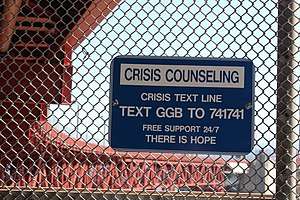
)%2C_OWID.svg.png)
